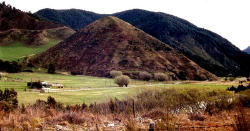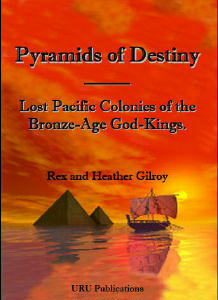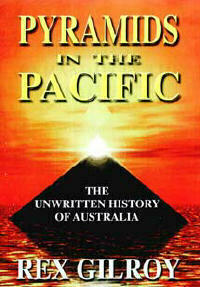
| Pyramids of Destiny – Lost Pacific Colonies of the Bronze-Age God-Kings |
![The Ha’amonga [Arch of Maui]](images/megaliths/archofmaui-sm.jpg) |
The Ha’amonga [Arch of Maui]. An early photograph of this famous trilithon located on Tonga Tapu. Mystery surrounds this massive structure, one of a number of other megalithic stoneworks found in the Tonga Island group. Are they, as some researchers suggest, the work of a Mediterranean or Middle-East people; or as the Gilroys suggest, an Uruan culture that survived the submergence of the “Lost Land of Wainga-roa” of ancient Moriori [New Zealand] tradition?
Photo courtesy Bernice Bishop Museum, Honolulu. |
Pyramids of Destiny – Lost Pacific Colonies of the Bronze-Age God-Kings
by Rex & Heather Gilroy
Copyright
© Rex Gilroy 2009
| “Australian history is almost always picturesque; indeed it is so curious and strange, that it is itself the chiefest novelty the country has to offer, and so it pushes all other novelties into second and third place. It does not read like history but like the most beautiful lies. Mark Twain: Following the Equator [1891] |
”Every truth passes through three stages before it is recognised. In the first, it is ridiculed. In the second, it is opposed. In the third, it is regarded as self evident.” Arthur Schopenhauer [1788-1860] |
Part One.
The Rise of Civilisation Out of Australia – The Children of the Uru.
Chapter Three.
Sunken Lands of Australantis.
The ancient traditions used in this chapter have been gathered by the authors in the course of our fieldwork throughout Australia and New Zealand, as well as various publications on Australoid, Melanesian and Polynesian mythology and legend. The skull-types described were found by the authors.Ancient traditions, from Island Micronesia, Melanesia and Polynesia to the Americas, speak of a lost land shelf or continental mass, which formerly covered a considerable expanse of the western and central Pacific region, and of which only islands now remain. In our book “Uru – The Lost Civilisation of Australia” [URU Publications 2005] Heather and I argue that this great
landmass extended south to include New Zealand [then a single landmass], and that this landmass was joined to New Guinea-Australia and the great land shelf extending to mainland Asia.
To the Maoris of New Zealand it was the “Lost Land of Wainga-roa”. It had, they believed, extended from present-day Cape Reinga, and had been submerged by the sea, a disaster in which whole tribes of people had perished. These were, among others, the Ngati-Kaiperu, or “People of Eru [or Uru]. Legends say they were a white-skinned race who built in stone, and whose ruined culture centres now lie submerged beneath the waters of the Pacific Ocean.
The Ngati-Kaiperu, both men and women, had the power of flight, and those who took to the air were given the name of ‘Tui’, or “Fly as a bird without flapping the wings”; in other words they were users of primitive hang-gliders.
The Ngati-Kaiperu, or Uru were said by the Polynesians to have built large stone temples and other monuments, which were abandoned as the ocean rose to cover the land. Some of these monuments are said to survive above water today, on many of the Pacific Islands.
Remarkably, the Antarctic continent occurs in the folklores of certain Victorian and South Australian Aboriginal tribes, as the former home of a fair-skinned race of Gods – the Uru – who apparently constructed great stoneworks in “tribal grounds” which we today would call culture centres, in a land of forests and waterways teeming with all manner of wildlife, until one day when the land was covered in quartz crystal. Surely, if there is any credence to these legends, it would appear that the Antarctic continent was once dry land and an extension of the Uruan civilisation.
Hotu Matua, the great blond-haired, fair-skinned culture-hero of Easter Island, is said to have arrived there with his followers, in a great “feather boat” [ie a vessel with sails], from a sunken land to the west. Hotu Matua subsequently introduced the art of stone building to the island. Obviously ‘Hotu Matua’ is symbolic of a whole people rather than an individual.
Wherever megalithic remains of the Uru are found so too is their rock script, which radiating out from Australia, is found eastwards across the Pacific to the Americas, and northwards through what is now island south-east Asia to the Euro-Asian continent and Africa. The reader can pursue these matters at greater length in “Uru – the Lost Civilisation of Australia”.
The Australian Aborigines have the giant bullfrog – Tidalik the flood-maker – who caused a flood, and is an obvious race-memory of the flooding that occurred in Australia at the close of the last great Ice-Age.
Similarly, the Iroquois Indians of the eastern United States possess the tradition that a giant bullfrog, the emblem of cold and water, had to be slain to release the waters of the earth which he had drunk up, like Tidalik. The American Indians, from the tribes of California, to the old megalithic cultures of Central America, all possess myths and legends of a great land, far across the Pacific, having been submerged in the ocean depths.
Old Maori creation mythology is linked to this land, the traditions of which had been handed down to them from the earlier inhabitants of New Zealand, the fair-skinned Uru.
The God Tane created this land, the stars overhead, including te-ika-matua-a-take-roa [“The parent fish of Taka-roa”] or Great Magellan Cloud” and Nga-patari [“the inviters”] or “Lesser Magellan cloud”. He then created Puaka [“blazed up”] or the Star Rigel, Takku-rua [“rim of the pit”], the star Sirius, both of which would preside over planting and harvest time; Wero-i-te-ninihi [“arouse the absconding”] and wero-i-te-kokoto [“arouse the expanse”], stars to preside over Summer.
The first man was Tiki, whom Tane created after he formed the earth [Papa]. He then created the first woman, Ma-riko-riko [Glimmer].
The great landmass he named Wainga-roa [Wainga – ‘gate’, roa – ‘long’], the surviving remnants of the later great submergence; North and South Island, would be named Aotearoa by the early Maori colonists [a name roughly meaning “Land of the Long White Cloud”].
To the west Tane created another land, joined to Wainga-roa, Uru, a name meaning ‘God’, for this land would become known as the Land of Gods. To the east Tane created yet another land - that of Matuku, the “Land where the Sun rose”, and which could only have been South America. Here is ancient geographical information revealing the extent of early Polynesian trans-ocean exploration.
A study of ancient mythology and legend reveals Wainga-roa was formed of hills, mountains and rivers flowing through deep valleys, populated with animals and birds of all kinds, and ruled over by the fair-skinned race created by Tane, the Ngati-Kaiperu, of “People of Eru” [or Uru]. This people were composed of large tribes, or communities who covered the landmass to its southernmost limits, which is what is now South Island – Stewart Island.
The true dimensions of the sunken landmass of Wainga-roa may be deduced from geological evidence and the traditions of the Melanesian and Polynesian peoples. Extending north from New Zealand the land shelf on its western side roughly followed the Norfolk Island Ridge up to what is now New Caledonia and on to the south-eastern portion of New Guinea; and on its eastern side followed the Kermadec and Tongan trenches, then eastwards perhaps as far as the Tuamotu archipelago, its northern shoreline roughly including the Tokelau and Ellice Islands across to the Solomons. An offshoot land shelf extended northwards from the Ellis Islands into Micronesia.
Archaeological and palaeoanthropological evidence demonstrates that such a massive pre-diluvian landmass was a reality. For example, old traditions of the native peoples of New Caledonia, the New Hebrides [Vanuatu], Fiji, Tonga, Samoa and Tahiti, as well as throughout island Melanesia, speak of former primitive stone tool-manufacturing giant-size to smaller hominids, who have left behind their fossilised footprints and implements as evidence of their former presence.
In Chapter One evidence has been presented demonstrating that Homo erectus was in Australia at the dawn of the Pleistocene period, and evolved into the earliest modern humans here before he did in Africa. Similar fossil evidence of his presence in Pleistocene New Zealand shows that Homo erectus reached this southernmost extension of the Wainga-roa land shelf, to evolve into modern humans here also, by around 350,000 years ago.
The reader can pursue the full story in “Uru – the Lost Civilisation of Australia” [URU Publications].
Main Book Index | Mysterious Australia Homepage | URU Homepage | Australian Yowie Research Centre

